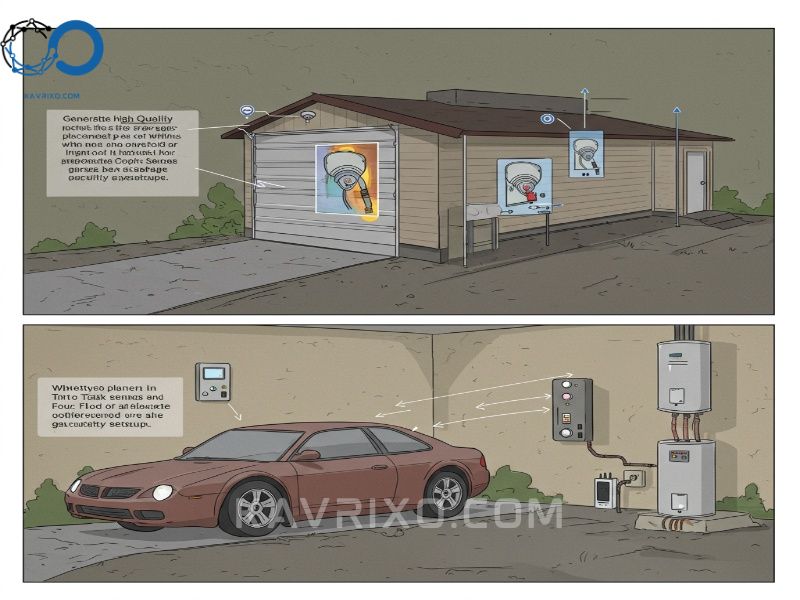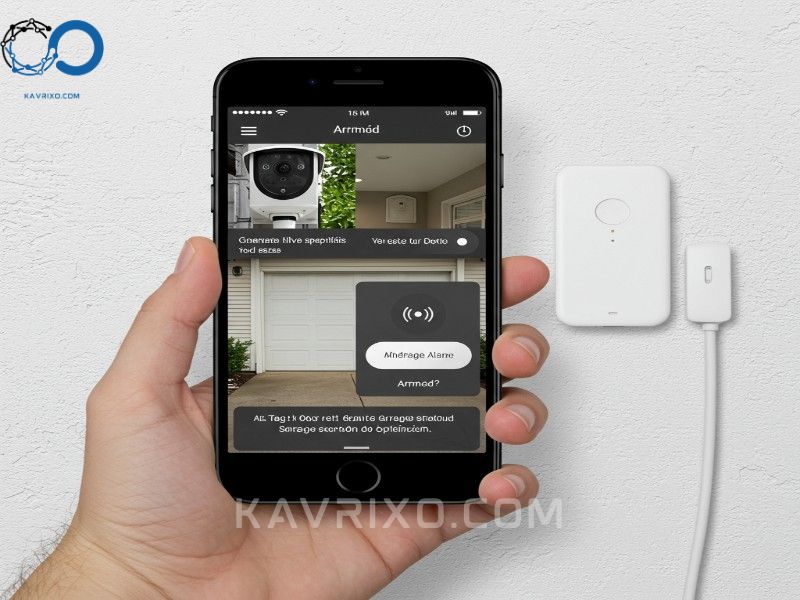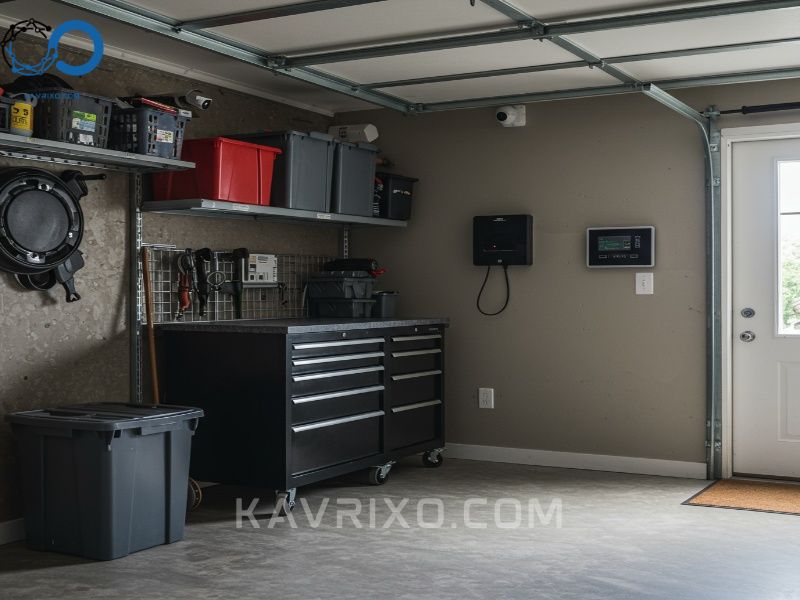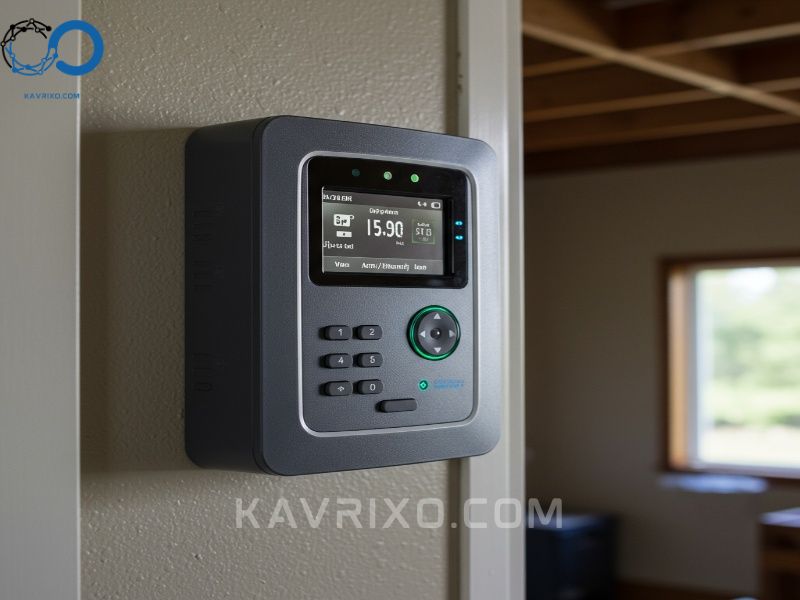The garage—often housing thousands of dollars in tools, vehicles, and sentimental belongings—is ironically one of the most neglected areas when homeowners assess their security needs. Many people rely solely on the thin latch of the overhead door or the standard lock on the entry door leading into the house. Unfortunately, professional and opportunistic thieves know this vulnerability well. Implementing a dedicated garage security system is no longer a luxury; it’s a fundamental necessity for comprehensive home protection.
In this exhaustive guide, we will explore why the garage is such a common target, detail the essential components of a robust garage security system, and walk you through the process of selecting the perfect garage door alarm and monitoring solution to safeguard your property and peace of mind.
Contents
- 1 Why the Garage is Your Home’s Weakest Link
- 2 Essential Components of a Modern Garage Security System
- 3 Deep Dive: Types of Garage Security Systems
- 4 Key Features to Look for in a Garage Door Security System
- 5 Installation Options: DIY vs. Professional Setup
- 6 Advanced Strategies for Total Garage Security
- 7 Final Considerations Before Purchasing Your Garage Security System
Why the Garage is Your Home’s Weakest Link
For intruders, the garage offers a unique combination of easy access and valuable inventory. Unlike front doors or first-floor windows, which are often visible from the street, the garage provides cover and multiple pathways to breach the home’s perimeter.
Understanding Common Entry Methods (The “5-Minute” Break-in)
Intruders use several common, quick methods to bypass traditional garage security measures. Understanding these methods is the first step in designing an effective defense using a garage burglar alarm system.
- The Coat Hanger/Wire Trick (J-Hooking): This classic method exploits a fundamental design flaw in many standard automatic garage door openers. If the emergency release cord (usually red) is visible, a thief can slide a coat hanger or thin wire through the small gap at the top of the garage door. They snag the cord, pull it, and manually open the door in seconds. A solid garage door security system must counter this physical vulnerability.
- Window Exploitation: Many garages feature small, often obscured windows. These are easy targets for smashing or prying open. Once inside the garage, the intruder has ample time and cover to work on the interior door leading into the main house, which is often less secure than the front door.
- Code Hijacking (Older Systems): Older garage door openers often rely on fixed or simple rolling codes, which can sometimes be “grabbed” or intercepted by sophisticated thieves using specialized devices. Modern garage alarm systems utilize complex encryption to defeat this tactic, but legacy systems remain highly vulnerable.
- The “Pry and Lift”: For manual or non-functioning doors, simple brute force using a crowbar can sometimes lift the door just enough to squeeze underneath, especially if there is no secondary internal lock or bolt mechanism installed alongside the automated opener.
Assets at Risk: Beyond the Car
While protecting vehicles is paramount, the value stored in a typical garage extends far beyond cars. When considering investing in a garage security system, remember the high-value items that are often targeted:
- Tools and Equipment: Power tools, specialized machinery, and gardening equipment are easy to sell and often unprotected.
- Sporting Goods and Hobby Gear: Bikes, golf clubs, kayaks, and fishing gear represent significant financial investment.
- Household Entry Point: The most critical risk is that once the garage is breached, the thief has a concealed area from which to attack the interior door, gaining full access to the home while remaining hidden from neighbors or street view. This transition phase is where a loud garage burglar alarm is essential.

Essential Components of a Modern Garage Security System
A truly effective garage security system employs a layered defense strategy, combining physical barriers, motion detection, and visual verification. This approach ensures that if one layer fails, the next one is ready to trigger the garage security alarm.
Perimeter Protection: The Crucial Garage Door Alarm
The primary line of defense focuses on detecting unauthorized entry through the main overhead door.
Tilt Sensors and Magnetic Contacts
The most common sensor type used for overhead garage doors is the tilt sensor. Unlike standard door sensors that use magnetic contacts (which work well for side doors), the tilt sensor detects the change in angle when the door begins to open.
- Tilt Sensors: These devices are mounted directly to the inside of the door and immediately alert the garage alarm system when the door moves from its closed position. They are highly reliable for overhead doors.
- Magnetic Contacts (Heavy-Duty): For side doors, pedestrian doors, or windows within the garage, standard magnetic contact sensors are used. Ensure these sensors are rated for garage environments, which can experience extreme temperature fluctuations.
Vibration and Glass Break Sensors
If an intruder attempts the “pry and lift” method or targets a window, standard tilt sensors may not activate immediately.
- Vibration Sensors: These are affixed to the door panel itself. If excessive force, such as prying or attempted cutting, is applied, the sensor detects the vibration and triggers the garage burglar alarm.
- Glass Break Detectors: Essential if your garage has windows. These sensors listen for the distinct frequency of breaking glass, providing instant notification.
Interior Monitoring: Motion and Environmental Sensors
Once the perimeter is addressed, interior monitoring ensures that if an intruder does gain entry, they are detected immediately, triggering the central garage security alarm.
Passive Infrared (PIR) Motion Detectors
PIR sensors are the backbone of internal garage security. They detect heat signatures moving within their field of view.
- Placement Strategy: In a garage, PIR sensors must be strategically placed to cover the main working area and, critically, the interior door leading into the home. They should be mounted high enough to avoid being easily tampered with but positioned to avoid false alarms triggered by pets or reflections.
- Pet Immunity: If you have pets that occasionally enter the garage, selecting a “pet-immune” PIR sensor prevents nuisance alarms while still detecting human-sized intruders.
Environmental Monitoring (The Non-Theft Threats)
A comprehensive garage security system protects against more than just theft. Garages often house water heaters, furnaces, and stored chemicals, making them susceptible to environmental hazards.
- Temperature Sensors: Extreme temperatures can damage stored items (e.g., paint, sensitive electronics). Some advanced garage alarm systems offer temperature monitoring, alerting you if the temperature drops too low (risk of freezing pipes) or rises too high.
- Flood/Water Sensors: Placing a small water sensor near a water heater, washer/dryer hookup, or floor drain can prevent devastating water damage.
- Carbon Monoxide/Smoke Detectors: Absolutely crucial, especially if the garage is attached to the house. These detectors must be integrated into the main garage alarm system for immediate notification.

Visual Deterrence: Integrating Cameras and Lighting
Cameras serve two essential functions: acting as a visual deterrent and providing critical evidence if a break-in occurs. Integrating them with your garage alarm system ensures that recording starts the moment a sensor is tripped.
High-Definition Security Cameras
Modern security cameras, especially those using AI, offer features specifically beneficial for garage surveillance:
- Wide Field of View (FOV): Garages are usually large, open spaces, requiring cameras with a broad FOV to minimize blind spots.
- Infrared (IR) Night Vision: Since garages are often completely dark at night, IR capabilities are mandatory for clear, usable footage.
- AI Object Detection: Advanced cameras can distinguish between vehicles, people, and general movement, reducing false alarms and ensuring that only relevant events trigger alerts on your garage security alarm app.
- Placement: Cameras should cover the main door entry point and, ideally, the interior door leading into the home.
Smart Lighting Integration
Lighting is a powerful deterrent. Integrating smart lights with your garage security system means that if the garage door alarm is tripped, floodlights immediately illuminate the area, startling the intruder and exposing their actions to neighbors or cameras.
- Motion-Activated Floodlights: Exterior lights should activate immediately upon detecting motion outside the garage.
- Interior Lights: If an intruder enters, having the interior lights instantly switch on can disorient them and make it clear they have been detected.
Deep Dive: Types of Garage Security Systems
When selecting a garage security system, homeowners generally face a choice between standalone systems designed purely for the garage, or fully integrated solutions that link the garage directly to the main home security panel.
Standalone Garage Alarm Systems (DIY Focus)
These systems are often battery-powered, easy to install, and ideal for detached garages or homeowners seeking a simple, low-cost solution focused primarily on the overhead door.
- Pros: Easy DIY installation, specific focus on the garage door alarm, and often require no monthly fees (local siren only).
- Cons: Lack connectivity to the main house system, may not offer cellular backup, and generally rely only on a very loud local siren (a garage alarm). They offer limited remote monitoring capabilities.
- Best Use Case: Detached garages where only basic perimeter protection is needed, or as a secondary layer of defense supplementing an existing, basic home system.
Integrated Home Security Solutions (Professional Focus)
The most robust protection comes from integrating the garage fully into a professional whole-home security network.
- How it Works: All garage sensors (tilt, motion, camera) report back to the central home hub. If the garage door security system is breached, the main panel contacts the monitoring station immediately.
- Pros: Professional 24/7 monitoring, cellular and battery backup, remote arming/disarming, and unified control via a single app. The response time is faster, and the deterrence factor is higher when the system is clearly labeled as professionally monitored.
- Cons: Higher upfront cost, mandatory monthly monitoring fees, and installation can be more complex, often requiring professional setup.
- Best Use Case: Attached garages and properties storing high-value assets where immediate, verified response is essential. This provides the strongest form of garage burglar alarm system protection.

Smart Garage Control Systems (The IoT Angle)
Beyond traditional security, smart systems integrate access control and automation, enhancing both convenience and security.
- Smart Openers: These replace or augment existing openers, allowing you to remotely open, close, and check the status of the garage door via an app. Receiving notifications if the door is left open accidentally is a huge benefit for garage security.
- Geofencing: Some systems use geofencing to automatically close the door if you leave the neighborhood and forget to shut it, eliminating one of the most common security lapses.
- Delivery Mode: Modern smart openers can be temporarily opened for verified package delivery drivers, ensuring packages are placed securely inside the garage without fully compromising the garage alarm system.
Key Features to Look for in a Garage Door Security System
Choosing the right components for your garage door security system requires careful scrutiny of features that ensure reliability and usability in challenging environments.
Connectivity and Remote Access
The value of a garage security alarm is greatly diminished if you don’t know it’s been triggered until you return home.
- Cellular Backup: Garages are susceptible to power outages and cut phone lines. A system with cellular backup ensures the monitoring station is notified even if the power is out or the internet connection is severed. This is a non-negotiable feature for any premium garage burglar alarm.
- Remote Management: The ability to check the status, arm/disarm the system, and view camera feeds from anywhere via a mobile device is critical. Look for systems with highly rated, intuitive apps.
- Two-Way Audio: If using cameras in the garage, two-way audio allows you to communicate with delivery drivers or, more importantly, issue a loud verbal warning to an intruder before they enter the main house.
Power Backup and Tamper Resistance
Reliability under stress defines a top-tier garage security system.
- Battery Life: All sensors and the main hub should have robust battery backup, typically lasting 12 to 24 hours minimum, ensuring protection during power failures.
- Encrypted Communication: Modern systems use advanced encryption (like Z-Wave or proprietary protocols) to prevent signal jamming or hacking, reinforcing the integrity of your garage alarm system.
- Protected Wiring: If opting for a wired system, ensure that all wiring is concealed or protected within conduit, preventing thieves from simply cutting the wires to disable the garage security.

Environmental Resilience
The garage environment is harsher than the interior of the home. Security components must be able to withstand these conditions.
- Temperature Rating: Ensure that sensors and cameras are rated to function in both sub-zero winter temperatures and extreme summer heat, which can easily exceed 100°F (38°C) in a non-climate-controlled garage.
- Dust and Moisture Resistance: Look for components with high IP (Ingress Protection) ratings, indicating resistance to dust accumulation and high humidity, which are common in garage settings.
Installation Options: DIY vs. Professional Setup
The complexity of your chosen garage security system usually dictates whether a DIY approach is feasible or if professional installation is necessary.
When DIY is Appropriate for a Garage Alarm System
Many modern garage alarm systems are designed for easy user installation, making them accessible to most homeowners.
- Simple Systems: If your goal is primarily to add a wireless tilt sensor and a single motion detector to an existing home security system, DIY installation is straightforward.
- Standalone Kits: Dedicated, battery-powered garage door alarm kits that rely on adhesive mounts and simple pairing procedures can typically be installed in less than an hour.
- Cost Savings: DIY eliminates labor costs, making the security investment more affordable.
Benefits of Professional Installation for Complex Systems
For integrated systems or setups involving multiple cameras and complex wiring, professional installation provides significant advantages.
- Optimal Placement: Professionals know exactly where to place PIR sensors to maximize coverage and minimize false alarms, especially in challenging garage layouts.
- Integration with Home Infrastructure: They ensure seamless communication between the garage security system and the main home panel, handling any necessary wiring or hard-to-reach component placements.
- Guaranteed Functionality: A professional install often comes with a warranty on the labor and configuration, ensuring the garage burglar alarm system functions perfectly from day one.
- Code Compliance: If the system requires connection to main power sources or involves fire safety components (like smoke/CO detectors), professional installers ensure all local codes are met.

Advanced Strategies for Total Garage Security
Maximizing the effectiveness of your garage security system requires looking beyond just the sensors and considering physical and digital defense layers.
Layered Defense: Physical Barriers and Smart Alarms
No matter how advanced your electronics are, physical barriers remain vital for slowing down intruders.
- Securing the Emergency Release: Use a plastic zip tie or wire to secure the emergency release mechanism without preventing it from functioning in a true emergency. The zip tie should be loose enough to pull free with significant force, but tight enough to prevent the casual snagging attempt using a coat hanger. This simple, cheap trick complements your garage door security system.
- Secondary Deadbolts: Install a high-quality deadbolt lock on the interior door leading from the garage into the house. Ensure the door frame is reinforced with longer screws, as this door is often kicked in by intruders who have gained easy access to the garage.
- Window Reinforcement: Apply security film to any garage windows. This film prevents glass from shattering instantly, delaying entry and making noise, giving your garage security alarm time to notify authorities.
Preventing “Code Grabbing” and Remote Hacking
If you haven’t upgraded your garage door opener in the last decade, it may be time to ensure it uses modern security protocols.
- Rolling Code Technology: Modern openers use “rolling code” or “Security+ 2.0” technology. This means the code transmitted by the remote changes every time it is used, making it virtually impossible for thieves to “grab” and replay the code to open the door. Ensure your garage security system is integrated with a modern opener.
- Wi-Fi Security: If your system uses Wi-Fi connectivity (common for smart cameras and smart openers), ensure your home network uses a strong password and WPA3 encryption to prevent remote hacking attempts.
Ensuring Your Garage Burglar Alarm System is Always Active
The biggest failure point in any security system is user error—forgetting to arm it.
- Auto-Arming Features: Utilize the auto-arm feature available on many modern systems. This sets the garage alarm automatically if the sensors detect no movement for a predefined period (e.g., 30 minutes after the last exit).
- Separate Zones: Program the garage sensors as their own distinct zone. This allows you to set the garage to “Away” mode even if the main house is set to “Stay” mode overnight, ensuring the perimeter remains secure while you are sleeping. A well-configured zone system ensures your garage burglar alarm system provides constant protection.

Final Considerations Before Purchasing Your Garage Security System
Before committing to a specific garage security system, take time to evaluate your specific needs and the environment of your garage.
- Assess Existing Vulnerabilities: Walk around your garage. Are the windows low? Is the interior door flimsy? Is the emergency release cord easily accessible? Prioritize the system components that directly address your weakest points.
- Evaluate Connectivity: Do you have reliable Wi-Fi coverage in the garage? If not, you may need a system that relies solely on cellular communication or invest in a Wi-Fi range extender. Poor connectivity will render any smart garage security alarm useless.
- Check Local Laws: Some municipalities have regulations regarding excessively loud or frequently triggered alarms. Familiarize yourself with local ordinances concerning your garage alarm system to avoid potential fines.
- Long-Term Costs: Factor in the cost of batteries, potential replacement sensors, and, most importantly, the monthly monitoring fees if you choose a professionally monitored garage door security system.
By treating the garage as a critical part of your home’s security perimeter, and by implementing a multi-layered, technologically advanced garage security system, you can significantly reduce your risk of property loss and ensure the safety of your entire household.
